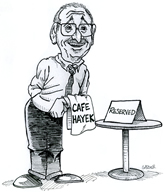Back in March, Jeff Horwich reported this:
In a Minneapolis Fed staff report, Monetary Advisor Michael Waugh models how lower trade costs play out for richer and poorer households (Staff Report 653, “Heterogeneous Agent Trade”). Waugh finds starkly different effects, with poor households (defined by their level of consumer spending) gaining much more as freer trade lowers prices.
The reason is not that poorer households buy a larger proportion of imported goods. Rather, it is their higher marginal utility of consumption: Falling prices provide more value to households with tighter budgets, as evidenced by their sensitivity to prices. Low-income households react more strongly as trade drives down the prices of imports and competing domestic goods. These households increase their consumption more as their buying power increases, and they are quicker to substitute new products in pursuit of savings.
Waugh finds that all U.S. households benefit from a 10 percent reduction in U.S. trade costs. But the poorest fifth of households experience a welfare gain more than 4.5 times larger than the richest.
Jon Miltimore explains the Ford Motor Co.’s massive retreat from EVs. A slice:
One reason charging infrastructure has lagged is due to the federal government’s incompetence. Nearly three years ago, the U.S. Departments of Transportation and Energy announced a $5 billion spending effort to build fleets of charging stations to lead “an electric vehicle revolution.” As of the summer of 2024, just seven charging stations had been built.
“That is pathetic,” said US Sen. Jeff Merkley, a Democrat from Oregon. “We’re now three years into this … That is a vast administrative failure.”
The decision of automakers to bet big on EV adoption was in some ways rational, in that they were responding to powers in Washington that were pressuring them and incentivizing them to expand electrical vehicle production. But the costs of listening to industry experts and politicians in Washington instead of consumers — and profits — have been severe.
In August 2023, NPR reported that Ford CEO Jim Farley was charging ahead with its ambitious EV expansion even though the company was “losing money on each EV it sells” and consumer demand for EVs was plummeting. Farley’s reasoning was that Ford was attracting new customers, but it was a costly endeavor. Ford reported a loss of $4.7 billion on EV sales in 2023, roughly $40,525 per vehicle sold.
Nevertheless, Progressives continue to try to force EVs on Americans, as the House of Representatives at least temporarily blocks this officiousness. A slice:
The House on Friday voted, 215-191, to overturn the Environmental Protection Agency’s vehicle emissions rule, with eight Democrats joining Republicans. Kamala Harris says she doesn’t support an electric vehicle mandate, but that’s what the Biden EPA rule effectively is.
The EPA in March finalized greenhouse gas emissions requirements for auto makers through 2032. EPA’s models show that gas-powered cars will make up no more than 30% of sales by 2032. EVs made up a mere 7.6% of auto sales last year and less than 4% for General Motors and Ford. In eight years they will have to increase their EV sales by some 15-fold.
The emissions standards are especially punitive for U.S. manufacturers that mostly sell trucks and SUVs. Companies will effectively have to produce one to two electric trucks for every gas-powered one in 2027 and closer to four to one by 2032. Yet electric trucks cost much more to produce than sedans since they require much bigger batteries.
Ford lost $44,000 on each EV sold in the second quarter, which is more than some of its trucks retail for. Auto makers are scaling back EV investment amid slowing demand. Ford announced last month it is cancelling production of an electric SUV and delaying an electric pickup. The same week Stellantis delayed retooling a shuttered plant in Belvidere, Ill., for EV production. The Energy Department awarded Stellantis $335 million in subsidies to convert the plant to make EVs. President Biden boasted about the plant in his State of the Union address this year.
Andrew Stuttaford decries the degrowthers’ ‘war on kitchens.’ A slice:
One of the rules of understanding climate fundamentalism (and other forms of environmentalist fundamentalism) is that, as is the case for most fundamentalisms, the quest for purity never stops.
“Degrowth” is one example of this. Its central proposition is that humanity should turn away from economic growth, and, at least in the West, be prepared to reduce the size of our economies in (supposedly) the interests of the planet. What that would mean in practice can vary, but can we see in this tweet by Aashis Joshi a sign that one day the war against gas stoves might be overtaken by the war against kitchens?
Joshis tweets:
When it comes to preparing & consuming food, communal kitchens would eliminate the need to have refrigerators, stoves, ovens, & other kitchen appliances in each home. They would reduce the consumption of materials & energy, & also food waste, by a lot.
In a later tweet, he explains that changes such as these would “require a radical reorganization of our societies & a shift of values, especially from individualism to collectivism.”
Indeed. And the methods by which this “radical reorganization” and “shift of values” would be arranged is unlikely to be either peaceful or democratic. And the methods by which they would then be maintained would be repressive.
“Kamala Harris is not an ideas candidate,” so writes Christian Britschgi. A slice:
The vice president says she wants to make housing more affordable by building more units and capping rent increases on existing units. But rent control has a well-earned reputation for reducing new construction. One plank of Harris’ housing affordability agenda is working against the other.
That seems like less “building” and “balancing” and more like just building less.
And if “upstream” antitrust enforcement is supposed to lessen the need for redistribution, as Jen Harris claims in her Times column, why is Kamala Harris still proposing a raft of new subsidies and tax credits? Despite all that building and balancing, we still need more redistribution too, I guess.
Dennis Murphy praises economic competition.
“How Covid destroyed our lives, from newborns to pensioners.” Two slices, from Rosa Silverman’s report in the Telegraph:
Yet a growing body of evidence suggests we haven’t truly turned the page on what now sounds more like a chapter from dystopian fiction. Instead, the effects of the Covid lockdowns endure, and will continue to be observed and charted for many decades to come. “We’ll probably be studying the impact of this for as long as we live,” says Adam Hampshire, professor of cognitive and computational neuroscience at King’s College London (KCL).
A startling reminder of the long-term fallout of those unprecedented restrictions came just this week, as new figures revealed that the number of people on sickness benefits rose to 3.9m, an increase of almost 40 per cent since the pandemic first hit.
That came hard on the heels of news this month that lockdowns may have caused premature ageing to teenagers’ brains. Research from the University of Washington found the measures resulted in “unusually accelerated brain maturation” in adolescents, and that this was far more pronounced in girls than boys. While the average acceleration in the development of the male adolescent brain was 1.4 years, for females it was 4.2 years.
If girls were more dramatically affected, this could be due to their heavier reliance on social relationships, the researchers have suggested.
…..
But this possibly masks the harmful and irreversible impact of lockdown on so many of pensionable age. Last year, a study led by the University of Exeter and KCL found cognitive function and working memory in older people declined rapidly during the first year of the pandemic, whether or not they actually contracted Covid. The pattern continued into 2021-22, with researchers citing the heightened loneliness and depression suffered during the lockdowns by this cohort, as well as a decrease in exercise and – again – increased drinking.


 It is no accident that Classical civilization developed in the Mediterranean, where cultures used sea transport to trade with each other and learn from each other.
It is no accident that Classical civilization developed in the Mediterranean, where cultures used sea transport to trade with each other and learn from each other. If the mortgage-underwriting standards in effect at Fannie and Freddie circa 2003 had remained in place, nothing on the magnitude of the subprime crisis would have occurred.
If the mortgage-underwriting standards in effect at Fannie and Freddie circa 2003 had remained in place, nothing on the magnitude of the subprime crisis would have occurred. Since his entire fiscal program depended on the customs duties flowing from a large overseas commerce, [Secretary of the Treasury Alexander] Hamilton was reluctant to weaken that overseas commerce for the sake of developing domestic commerce.
Since his entire fiscal program depended on the customs duties flowing from a large overseas commerce, [Secretary of the Treasury Alexander] Hamilton was reluctant to weaken that overseas commerce for the sake of developing domestic commerce. Nor is there anything which tends more to discredit and frustrate the better means of influencing conduct, than a resort to the worse.
Nor is there anything which tends more to discredit and frustrate the better means of influencing conduct, than a resort to the worse.
